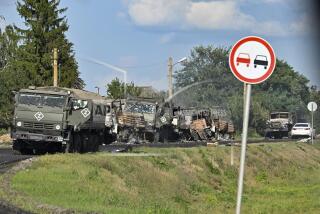Soviet Troops Keep Close Watch in Armenian Capital
- Share via
MOSCOW — Soviet troops and helicopters patrolled the Armenian capital of Yerevan on Friday, prepared to stifle any demonstration by Armenian activists over the disputed region of Nagorno-Karabakh.
Armenian authorities, reached by telephone in Yerevan, said they could not estimate the strength of the Soviet forces involved, but they said the helicopters were making passes over the city and that soldiers were patrolling the streets in a show of force designed to discourage outbreaks of nationalism. Moscow banned such demonstrations in a decree issued Wednesday.
Leaders of the campaign to press for the incorporation of Nagorno-Karabakh, an autonomous region, into the Soviet republic of Armenia had called for large demonstrations today, but that was before the Presidium of the Supreme Soviet adopted a resolution banning unauthorized demonstrations. About 75% of the people in the disputed region, which is situated within the neighboring republic of Azerbaijan, are Armenian.
Clear Effort
The Soviet government, while denouncing as unacceptable any further “nationalistic and extremist manifestations,” was making a clear effort--in the wake of what appeared to be its final word on the dispute--to respond to the grievances of Armenians in the region. The Christian Armenians have complained that they are discriminated against by the government and population of Azerbaijan, which is predominantly Muslim.
First Deputy Premier Vladimir Lakhtin announced that the equivalent of $670 million will be spent in Nagorno-Karabakh over the next seven years. Capital improvements will include a 400-bed hospital and at least nine schools. In addition, he said, water and gas supplies will be improved, roads upgraded and reservoirs and factories built. The capital of the region, Stepanakert, will be provided with a new, 850-seat theater.
The government promised to ensure that residents of Nagorno-Karabakh will be able to receive Armenian television programs, a sore point frequently mentioned by Armenians from the area. They say they are beset with Azerbaijani and Muslim propaganda, and were unable to receive news and other programs in their native language.
Lakhtin also said that printing equipment will be imported into the region to permit publication of books and periodicals in the Armenian language.
Tacit Recognition
It is not certain whether the new measures will satisfy the Armenian activists, but the steps taken by the government seem at least a tacit recognition that some of their grievances are valid.
The turmoil that erupted in the two republics a month ago seemed to be a direct challenge to the policy of openness espoused by Soviet leader Mikhail S. Gorbachev, who personally appealed for calm in the region and suggested that he would give the matter his personal attention.
Afterward, however, the disturbances continued, culminating in two days of violence Feb. 28 and 29 in the Azerbaijani city of Sumgait. By official count, 32 people were killed and nearly 200 were injured. Most of the casualties were assumed to be Armenian, although the government has said the victims were of several nationalities.
A strong force of Soviet troops was moved into Sumgait after the violence and has remained there. The city is under a nighttime curfew.
Tense Atmosphere
The situation has been calm since then, although Soviet spokesmen, in refusing foreign reporters permission to enter the area, have said the atmosphere is tense.
In the wake of the Sumgait violence, the Moscow authorities apparently felt they had no choice but to stop the demonstrations entirely and to try to ease Armenian stress in Nagorno-Karabakh with a plan of capital improvements and a more strenuous effort to resolve their complaints of cultural isolation.
More to Read
Sign up for Essential California
The most important California stories and recommendations in your inbox every morning.
You may occasionally receive promotional content from the Los Angeles Times.













